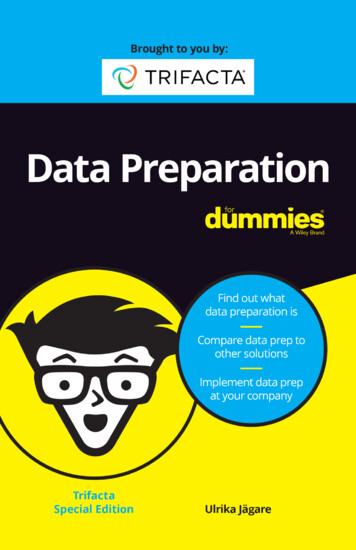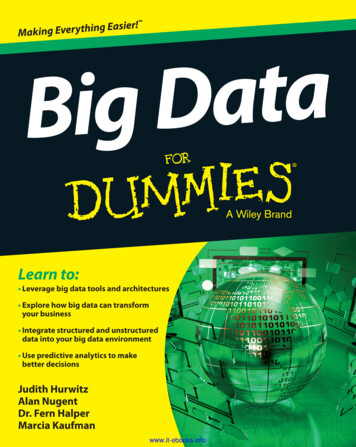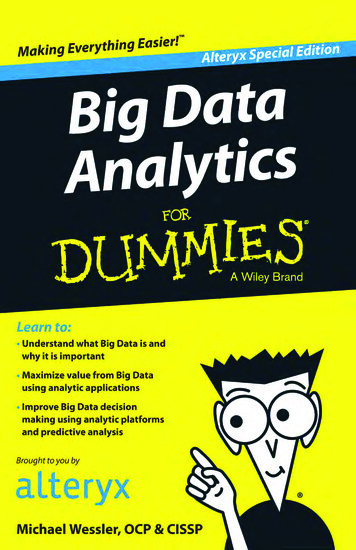
Transcription
These materials are 2020 John Wiley & Sons, Inc. Any dissemination, distribution, or unauthorized use is strictly prohibited.
DataPreparationTrifacta Special Editionby Ulrika JägareThese materials are 2020 John Wiley & Sons, Inc. Any dissemination, distribution, or unauthorized use is strictly prohibited.
Data Preparation For Dummies , Trifacta Special EditionPublished byJohn Wiley & Sons, Inc.111 River St.Hoboken, NJ 07030-5774www.wiley.comCopyright 2020 by John Wiley & Sons, Inc.No part of this publication may be reproduced, stored in a retrieval system or transmitted in anyform or by any means, electronic, mechanical, photocopying, recording, scanning or otherwise,except as permitted under Sections 107 or 108 of the 1976 United States Copyright Act, withoutthe prior written permission of the Publisher. Requests to the Publisher for permission shouldbe addressed to the Permissions Department, John Wiley & Sons, Inc., 111 River Street, Hoboken,NJ 07030, (201) 748-6011, fax (201) 748-6008, or online at http://www.wiley.com/go/permissions.Trademarks: Wiley, For Dummies, the Dummies Man logo, The Dummies Way, Dummies.com,Making Everything Easier, and related trade dress are trademarks or registered trademarks ofJohn Wiley & Sons, Inc. and/or its affiliates in the United States and other countries, and may notbe used without written permission. Trifacta and the Trifacta logo are registered trademarks ofTrifacta. All other trademarks are the property of their respective owners. John Wiley & Sons,Inc., is not associated with any product or vendor mentioned in this book.LIMIT OF LIABILITY/DISCLAIMER OF WARRANTY: THE PUBLISHER AND THE AUTHOR MAKE NOREPRESENTATIONS OR WARRANTIES WITH RESPECT TO THE ACCURACY OR COMPLETENESS OFTHE CONTENTS OF THIS WORK AND SPECIFICALLY DISCLAIM ALL WARRANTIES, INCLUDINGWITHOUT LIMITATION WARRANTIES OF FITNESS FOR A PARTICULAR PURPOSE. NO WARRANTYMAY BE CREATED OR EXTENDED BY SALES OR PROMOTIONAL MATERIALS. THE ADVICEAND STRATEGIES CONTAINED HEREIN MAY NOT BE SUITABLE FOR EVERY SITUATION. THISWORK IS SOLD WITH THE UNDERSTANDING THAT THE PUBLISHER IS NOT ENGAGED INRENDERING LEGAL, ACCOUNTING, OR OTHER PROFESSIONAL SERVICES. IF PROFESSIONALASSISTANCE IS REQUIRED, THE SERVICES OF A COMPETENT PROFESSIONAL PERSON SHOULD BESOUGHT. NEITHER THE PUBLISHER NOR THE AUTHOR SHALL BE LIABLE FOR DAMAGES ARISINGHEREFROM. THE FACT THAT AN ORGANIZATION OR WEBSITE IS REFERRED TO IN THIS WORKAS A CITATION AND/OR A POTENTIAL SOURCE OF FURTHER INFORMATION DOES NOT MEANTHAT THE AUTHOR OR THE PUBLISHER ENDORSES THE INFORMATION THE ORGANIZATIONOR WEBSITE MAY PROVIDE OR RECOMMENDATIONS IT MAY MAKE. FURTHER, READERSSHOULD BE AWARE THAT INTERNET WEBSITES LISTED IN THIS WORK MAY HAVE CHANGED ORDISAPPEARED BETWEEN WHEN THIS WORK WAS WRITTEN AND WHEN IT IS READ.For general information on our other products and services, or how to create a custom For Dummiesbook for your business or organization, please contact our Business Development Department inthe U.S. at 877-409-4177, contact info@dummies.biz, or visit www.wiley.com/go/custompub.For information about licensing the For Dummies brand for products or services, contactBrandedRights&Licenses@Wiley.com.ISBN: 978-1-119-70156-9 (pbk); ISBN: 978-1-119-70158-3 (ebk)Manufactured in the United States of America10 9 8 7 6 5 4 3 2 1Publisher’s AcknowledgmentsSome of the people who helped bring this book to market include the following:Project Editor:Carrie Burchfield-LeightonProduction Editor:Tamilmani VaradharajSr. Managing Editor: Rev MengleBusiness DevelopmentRepresentative: Karen HattanAcquisitions Editor: Katie MohrThese materials are 2020 John Wiley & Sons, Inc. Any dissemination, distribution, or unauthorized use is strictly prohibited.
Table of ContentsINTRODUCTION. 1About This Book. 1Icons Used in This Book. 2Beyond the Book. 2CHAPTER 1:Exploring Different Approaches toData Preparation. 3Describing How Legacy ETL Works. 4Sorting Out Excel/Manual Coding. 6Explaining SQL/In-Database Coding. 7Using a Desktop-Only Tool. 8Describing Embedded Data Preparation in an Analytics Tool. 9Diving into a Cloud-Based Data Preparation Solution. 10CHAPTER 2:Explaining Modern Data Preparation. 11Walking through the Data Preparation Workflow. 12Data quality. 13Data transformation. 14Data pipelining. 15Identifying the Principles of Data Discovery and Profiling. 15Enhancing Data Transformation with Machine Learning. 17Cleaning Data to Improve Data Quality. 19Running Data Preparation in Production. 20CHAPTER 3:Describing Team Roles in Data Preparation. 23Is Data Preparation for Anyone?. 24Describing Roles in Data Preparation. 25Data analysts. 26Data engineers. 26Data scientists. 27Data architects. 27Analytics leaders/executives. 28Applying Team Collaboration in Data Preparation. 28Learning from a Customer Example. 30The solution. 31The result. 31Table of ContentsiiiThese materials are 2020 John Wiley & Sons, Inc. Any dissemination, distribution, or unauthorized use is strictly prohibited.
CHAPTER 4:Emphasizing the Value of ProperData Preparation. 33Introducing Trifacta’s Data Preparation Platform. 34User experience. 35Enterprise security and governance functions. 36Ecosystem and extensibility. 37Learning from Data Preparation in the Real World. 38IQVIA. 38PepsiCo. 40CHAPTER 5:ivTen Benefits of a Cloud DataPreparation Solution. 43Data Preparation For Dummies, Trifacta Special EditionThese materials are 2020 John Wiley & Sons, Inc. Any dissemination, distribution, or unauthorized use is strictly prohibited.
IntroductionToday’s data is more diverse and complex than ever before.It’s time-consuming and technically challenging to preparethe data into a format suitable for analysis. The awarenessthat data is not only important but also in fact your company’smost valuable asset is growing fast in the industry. Data is vitalfor ensuring that organizational information is accurate, timely,complete, cost-effective, and accessible, and that it enables you totake proactive and conscious decisions throughout the business.Data is the foundation of business information and knowledgeand ultimately the wisdom for correct decisions and actions. Ifthe data is relevant, accurate, meaningful, and actionable, it helpsin the growth of the organization. If not, it can prove to be uselessand even harmful to a scaling enterprise.Therefore, treating your data correctly becomes a fundamentallyimportant task. Getting your data preparation, or data wranglingas it’s also referred to in this book, right is essential in order toincrease the quality of the data and information. Ultimately, it’sall about making it possible for you and your company to be ableto effectively use and rely on the data at hand.About This BookThis short book is packed with useful information about datapreparation. In this book, you not only learn about the shift fromdesktop or on-premises data preparation solutions to cloudbased platforms but also what the main principles of data preparation are all about.You discover that data preparation is no longer a task just foraccomplished data engineers or one that requires coding skills,and I give you a bit about the new cloud-based solution fromTrifacta and how it democratizes data preparation, making itachievable for anyone.Introduction1These materials are 2020 John Wiley & Sons, Inc. Any dissemination, distribution, or unauthorized use is strictly prohibited.
Icons Used in This BookI occasionally use special icons to focus attention on importantitems. Here’s what you find:This icon reminds you about information that’s worth recalling.Expect to find something useful or helpful by way of suggestions,advice, or observations here that help you leverage experiencesfrom other implementations.Warning icons are meant to get your attention to steer you clearof potholes, money pits, and other hazards. Paying extra attentionto these parts in the book help you avoid unnecessary roadblocks.This icon may be taken in one of two ways: Techies will zero inon the juicy and significant details that follow; others will happilyskip ahead to the next paragraph.Beyond the BookThis book can help you explore general strategies for how toapproach data preparation in your company. However, this bookis a relatively short introduction to data preparation, so for further reading and deep dives on the topic, the following books andarticles are recommended:»» Data preparation vs. ETL in the cloud: -futurecloud»» Self-service data preparation for messy files: data-ebook»» Learn more about Trifacta: www.trifacta.com2Data Preparation For Dummies, Trifacta Special EditionThese materials are 2020 John Wiley & Sons, Inc. Any dissemination, distribution, or unauthorized use is strictly prohibited.
IN THIS CHAPTER»» Explaining data management usingtraditional ETL»» Using Excel/manual coding in datapreparation»» Sorting out how SQL/in-database codingworks»» Listing benefits and drawbacks»» Using data preparation functionality»» Exploring flexibility in cloud-basedsolutionsChapter1Exploring DifferentApproaches to DataPreparationThere is a common misperception that data analysis is mostlya process of running statistical algorithms on highperformance data engines. In practice, this is just the finalstep of a longer and more complex process where 80 percent of ananalyst’s time is spent wrangling data to get it to the point atwhich this kind of analysis is possible. Not only does datawrangling consume most of an analyst’s workday, but also itrepresents much of the analyst’s professional process. It capturesactivities like understanding what data is available, choosingwhat data to use and at what level of detail, understanding how tomeaningfully combine multiple sources of data, and deciding howto distill the results to a size and shape that can drive downstreamanalysis.CHAPTER 1 Exploring Different Approaches to Data Preparation3These materials are 2020 John Wiley & Sons, Inc. Any dissemination, distribution, or unauthorized use is strictly prohibited.
Many companies have invested a lot of time and money into thenotion of putting all their data in one common storage locationand then thinking all their problems will be solved. However,companies soon discover that despite all their efforts, the data isstill difficult to find, access, and use. Succeeding with data management for analytics, reporting, and machine learning is clearlyabout a lot more than just data storage.You can perform data preparation through many methods, tools,and techniques that range from being manual to highly automated and efficient. This chapter aims to describe different waysto perform data preparation, including benefits and limitationswith each approach.Describing How Legacy ETL WorksExtract, Transform, Load (ETL) is a commonly used term acrossthe industry. It refers to the process of»» Extraction: Extraction is pulling data from many sources(traditionally relational databases). The data collection canbe done as full extraction or partial extraction.»» Transformation: Data is transformed to ensure consistencyin analysis. This process typically includes changing thedata’s format; standardizing values such as currencies, unitsof measurement, and time zones; enriching and validatingthe data to eliminate missing values and duplicates; andapplying business rules.»» Loading: This includes loading and writing the data into thetargeted storage unit: the database for use in an application,business intelligence solution, or data analysis product.An overview of the traditional ETL process is described in Figure 1-1.The process is linear and usually assumes IT responsibility forETL activities in an organization. Legacy ETL is slow and requiresmany iterations.4Data Preparation For Dummies, Trifacta Special EditionThese materials are 2020 John Wiley & Sons, Inc. Any dissemination, distribution, or unauthorized use is strictly prohibited.
FIGURE 1-1: A traditional ETL process.For a relatively long time, businesses have been relying on IT torun the ETL process to get a consolidated view of their data, notby the individuals who understood the data best. To ensure thatthe data is properly prepared and can be relied on for making better business decisions, it’s vital to understand the data and thebusiness context. Getting ETL right is still a core component of anorganization’s data integration system.For many years, traditional ETL was the only way to get data readyfor analysis. The ETL process, however, comes with its own challenges and flaws that can potentially contribute to various sets oflosses in any ETL activity.Integrating data across different sources is challenging. It entailsprogramming of scripts to parse the source data. If standard drivers aren’t available, coding will be needed to complete the desiredfunction.Building a representative architecture for an ETL project can alsobe tricky because you can’t actually see the data in ETL processes.Going straight to coding without taking into consideration theoverall bigger picture can cause serious problems for your teamperforming an ETL job.The quality of data and various types of dependencies that existin the data can impact the ETL process, as well as the complexity of the data relationships. When accessing data from differentsystems and moving data into the cloud, the quality of the datacan’t always be ensured. The data may be inconsistent, too, generating even more delays and cost to the ETL activity. However,once the data moves to the cloud environment, data preparationcan be used to transform it for further use.CHAPTER 1 Exploring Different Approaches to Data Preparation5These materials are 2020 John Wiley & Sons, Inc. Any dissemination, distribution, or unauthorized use is strictly prohibited.
Compatibility of the data source and target data (to merge with)and scalability of the ETL process are other common technicalchallenges. Scalability can be a tricky issue that you may comeacross, and it depends on the size of the data you’re dealing with.There can be operational changes in source data systems andongoing revisions to target schema definitions and scope. This alladds complexity to the ETL process, although scalability limitations can usually be addressed through a cloud-based architectural setup.Sorting Out Excel/Manual CodingAlthough Excel isn’t the optimal way of doing data preparation, it is still a widely used tool. This is especially true when thedataset is small and when the purpose is more of a one-time datapreparation exercise. Once you need to scale-up your datasets andexpand your data preparation activities to be spread over severalteams, you quickly realize that manual coding Excel does notreally scale, or support team collaboration efforts. The truth isthat collaboration in Excel is basically impossible.Since the only way to get value out of your data is to first preparethe data properly, it’s important to know that the most timeconsuming part in Excel is data cleansing using manual coding.It’s usually extremely slow and difficult. However, this step isimportant because the cost of a mistake caused by incompleteinformation, discrepancies, and outliers can cause serious faults inyour analysis that could significantly impact business outcomes.Remember that keeping track of data lineage, meaning your dataorigin, what happens to it, and where it moves, is a vital part ofdata preparation.Unfortunately, there are often unrealistic expectations on howlong data preparation should take. Your manager may think thatyou can click a few buttons to transform a raw dataset into actionable analysis within an hour or two, but the reality is, no matterhow powerful Excel is, it can still take several hours and more tomanually compile and clean your data using spreadsheets. And ifmore complex coding or programming is needed to complete youranalysis, you may have to take an online tutorial to learn how toperform a task or involve the IT department, both of which canadd time and effort that further add to the time it takes to get thedata cleaned.6Data Preparation For Dummies, Trifacta Special EditionThese materials are 2020 John Wiley & Sons, Inc. Any dissemination, distribution, or unauthorized use is strictly prohibited.
During the analysis process, spreadsheets continuously evolve,increase in complexity, and become more susceptible to errors.Then, when multiple spreadsheets and datasets are being usedwith many different calculations, it’s easy to lose your place,which makes it difficult to find and correct a mistake you mayhave made several changes earlier. And when using Excel, p eoplerarely document their various dataset versions, and versioncontrol becomes a problem. All these issues could lead to a lotof wasted time spent troubleshooting and doing additional datacleaning, making collaboration extremely difficult.Explaining SQL/In-Database CodingSQL is the main programming language that allows your databaseservers to store and edit the data on it. In database systems, SQLstatements are used to generate queries from a client program tothe database. This allows the users to execute a wide range of fastdata manipulation in the database.The range of functions offered within most implementations ofSQL has tended, however, to fall short of the needs of someonedoing data preparation beyond the need to join tables togetherand apply filters to slim down the amount of data to be transferred to the environment where the real analysis will be performed, usually in R or Python.Yet many of us use SQL regularly because the data we use lives ina SQL compliant database, and if we want to do something with it,we have to write a query.Although SQL is commonly used by engineers in software development, it’s also popular with data analysts for a few reasons:»» It’s semantically easy to understand and learn.»» Because it can be used to access large amounts of datadirectly where it’s stored, analysts don’t have to copy datainto other applications.»» Compared to spreadsheet tools, data analysis done in SQL iseasy to audit and replicate. For analysts, this means no morelooking for the cell with the typo in the formula.CHAPTER 1 Exploring Different Approaches to Data Preparation7These materials are 2020 John Wiley & Sons, Inc. Any dissemination, distribution, or unauthorized use is strictly prohibited.
»» SQL is great for performing the types of aggregations thatyou might normally do in an Excel pivot table — sums,counts, minimums and maximums, etc. — but over muchlarger datasets and on multiple tables at the same time.Have a look at the disadvantages of SQL:»» Complex interface: Because SQL has a complex structure, itbecomes difficult for certain users to access it.»» Implementation: Collaboration support is weak as is supportfor data lineage. Certain databases also implement proprietaryextensions to standard SQL, which causes vendor lock-in.»» Partial control: Because there are certain hidden rules andconditions, the programmers who use SQL don’t have powerover the database.»» Expensive: The time and cost involved in running SQLoperations daily are too high.Using a Desktop-Only ToolA typical desktop data preparation tool, for example, Alteryx,often takes a traditional client-server approach, with the desktopclient deployed outside of the cloud, usually on-premises. Exceland certain ETL vendors fall into this category. A desktop-onlytool is normally used for handling departmental-level data preparation jobs for a small number of users who require little collaboration with each other.The desktop-only data prep tool does come with its drawbacks:»» It isn’t integrated with cloud services and can’t scale withincreasing data volumes as a result of that.»» When a desktop-only tool needs to deal with enterprise-scaledata preparation projects in the cloud, it can’t leverage thenative cloud services to deliver elastic scalability and costefficiency.Instead, the desktop-only solution requires a number ofproprietary, separate component systems to be deployed in8Data Preparation For Dummies, Trifacta Special EditionThese materials are 2020 John Wiley & Sons, Inc. Any dissemination, distribution, or unauthorized use is strictly prohibited.
the cloud to manage governance, job orchestration,execution, and sharing.»» To overcome the scale limitation, users have to eitherover-provision every worker node to accommodate thelargest possible workload or add more infrastructure tomeet the growing demand and performance requirements.Both these approaches drive up management complexityand cost.»» Desktop-only data preparation solutions don’t provide agilitydue to its legacy waterfall design approach.»» Whenever an error occurs during the data preparationprocess, a user can’t easily identify the root cause of theissue when there’s no real-time visibility into the process.Instead, the user must restart the entire process in order toscrutinize all the transformation steps. Such rigid designleads to longer analytics development cycles and delayedtime to results and basically means that your downstreamuse of the data is limited to that tool, whereas organizationshave many analytics tools. A single department could havemore than ten tools.Other limitations with a desktop-only tool also include the lackof team collaboration support since this approach is focused onoptimizing for one user. Another consequence of this approach isalso poor data lineage control over the data life cycle.Describing Embedded Data Preparationin an Analytics ToolAnalytics tools exist both as desktop-only solutions and cloudnative solutions and many of these tools comes with a built-indata preparation capability. So, why not just use that one? Well,like any other application on the market, additional capabilitiesadded to the main capability of the application have a tendency tooffer basic functions but insufficient support. To put it simply, ananalytics tool is built to first and foremost enable great analytics,not to prepare data. Of course it can offer you basic functionality,but be prepared for it to use pretty rudimentary data preparationfunctions.CHAPTER 1 Exploring Different Approaches to Data Preparation9These materials are 2020 John Wiley & Sons, Inc. Any dissemination, distribution, or unauthorized use is strictly prohibited.
If you’re looking for some powerful, dynamic, flexible, and scalable data preparation support with the ability to scale, automate,and utilize artificial intelligence (AI) support, you won’t findthat embedded in an analytics solution, no matter how good theanalytics solution is. Usually the analytics vendor sells the datapreparation application separately with predefined and easy-touse application programming interfaces (APIs) to the analyticssolution.Diving into a Cloud-Based DataPreparation SolutionA data preparation solution designed for the cloud is a criticalcomponent of your modern analytics and machine learning stack.With tight integration with the native cloud services, an interactive web-based user experience, as well as enterprise-class, centralized governance, and execution, a data preparation solutionarchitected for the cloud allows organizations to explore and runa wide range of use cases at scale.However, data in the cloud can be extremely messy, and messydata provides no value until it’s cleaned up. To get data ready foranalytics on cloud, companies need to take into considerationboth the characteristics of the data and the use cases they want toexplore in a cloud environment and select a data preparation solution designed for the cloud as part of their modern analytics stack.To address the demanding requirements for scaling, performance, and management associated with the analytic projects oncloud, the architecture of a data prep solution is crucial. The modern solution, when compared with legacy desktop-only data preptools, follows a fundamentally different design principle.Another aspect to consider is user experience. When expandingyour company’s analytics adoption in the cloud, this becomesvery important. With most data now stored in cloud data lakes anddata warehouses, users with various skill sets have easier accessto the data without relying on IT to provision the data for them. Amodern, cloud-native data preparation solution can empower alltypes of users, from technical to business users to easily wranglethe data in the cloud with an intuitive, modern data preparationinterface.10Data Preparation For Dummies, Trifacta Special EditionThese materials are 2020 John Wiley & Sons, Inc. Any dissemination, distribution, or unauthorized use is strictly prohibited.
IN THIS CHAPTER»» Introducing the fundamental parts ofdata preparation»» Describing the key cornerstones of dataprofiling»» Explaining how machine learningenhances data transformation»» Learning key principles in cleaning datato improve data quality»» Industrializing data preparationChapter2Explaining Modern DataPreparationData preparation, also called data wrangling, is the process ofcleaning, structuring, and enriching raw data into a desiredformat for better decision-making in less time. This modern, self-service approach has three fundamental segments, whichinclude data quality, data transformation, and data pipelines.Data preparation is a necessity in any company, but at the sametime, the way it’s approached in many companies is still notespecially efficient. Despite the best efforts and intentions inmost companies and organizations, it’s widely acknowledged thatdata preparation still accounts for up to 80 percent of the effortin any data science initiative. On top of that, data has becomemore diverse and unstructured, which means that more timeneeds to be spent on removing, cleaning, and organizing data toenable any type of analysis to be made. At the same time, withan increased focus on data-driven businesses, the dependency onquality data is stressing the importance of a self-service enabled,reliable, and efficient data preparation capability. As data starts toinfluence just about every business decision, business users haveCHAPTER 2 Explaining Modern Data Preparation11These materials are 2020 John Wiley & Sons, Inc. Any dissemination, distribution, or unauthorized use is strictly prohibited.
less time to wait for the data and require self-service capabilitiesin data preparation.One way to speed up the data preparation flow is through aself-service model, which lessens the dependency on an IT-leddata preparation, to a more democratized model of self-servicedata preparation/wrangling.In this chapter, I introduce you to the fundamentals of the datapreparation workflow and explain some of the key concepts foryou to grasp in order to get your data management efforts working more efficiently.Walking through the DataPreparation WorkflowIn its simplest form, data preparation is the method of collecting,cleaning, processing, and consolidating the data for use in analysis. Simply put, it enriches the data, transforms it, and improvesthe accuracy of the analytical outcome. It’s a step in the analyticalprocess that consumes a significant amount of time and effort.However, too many people regard data preparation as janitorialwork — as an unglamorous rite of passage before sitting down todo “real” work, meaning, for example, the task of data analyticsor training a machine learning (ML) model.The fact is, data preparation is as much a part of the data analysisprocess as the final results are. Data preparation, when it’s properly conducted, gives you insights i
the data into a format suitable for analysis. The awareness that data is not only important but also in fact your company’s most valuable asset is growing fast in the industry. Data is vital for ensuring that organizational information is accurate, timely, complete, c











